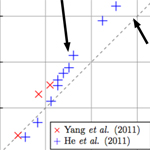Home > Press > Electrons are not enough: Cuprate superconductors defy convention
 |
| Graph showing the breakdown of Luttinger's theorem in the normal state of cuprate superconductors. The horizontal axis is the expected number of mobile electrons while is the vertical axis is the measured number. The two should be equal if the theorem were true. Graphic by Philip Phillips |
Abstract:
To engineers, it's a tale as old as time: Electrical current is carried through materials by flowing electrons. But physicists at the University of Illinois and the University of Pennsylvania found that for copper-containing superconductors, known as cuprates, electrons are not enough to carry the current.
Electrons are not enough: Cuprate superconductors defy convention
Champaign, IL | Posted on March 18th, 2013"The story of electrical conduction in metals is told entirely in terms of electrons. The cuprates show that there is something completely new to be understood beyond what electrons are doing," said Philip Phillips, a professor of physics and of chemistry at the U. of I.
In physics, Luttinger's theorem states that the number of electrons in a material is the same as the number of electrons in all of its atoms added together. Electrons are the sub-atomic particles that carry the current in a conductive material. Much-studied conducting materials, such as metals and semiconductors, hold true to the theorem.
Phillips' group works on the theory behind high-temperature superconductors. In superconductors, current flows freely without resistance. Cuprate superconductors have puzzled physicists with their superconducting ability since their discovery in 1987.
The researchers developed a model outlining the breakdown of Luttinger's theorem that is applicable to cuprate superconductors, since the hypotheses that the theorem is built on are violated at certain energies in these materials. The group tested it and indeed found discrepancies between the measured charge and the number of mobile electrons in cuprate superconductors, defying Luttinger.
"This result is telling us that the physics cannot be described by electrons alone," Phillips said. "This means that the cuprates are even weirder than previously thought: Something other than electrons carries the current."
"Theorists have suspected that something like this was true but no one has been able to prove it," Phillips said. "Electrons are charged. Therefore, if an electron does not contribute to the charge count, then there is a lot of explaining to do."
Now the researchers are exploring possible candidates for current-carriers, particularly a novel kind of excitation called unparticles.
Phillips, U. of I. undergraduate student Kiaran Dave (now a graduate student at MIT) and University of Pennsylvania professor Charles Kane published their findings in the journal Physical Review Letters. The National Science Foundation and the Center for Emergent Superconductivity (through a DOE Energy Frontiers Research Center) supported this work.
####
For more information, please click here
Contacts:
Liz Ahlberg
Physical Sciences Editor
217-244-1073
Philip Phillips
217-244-6703
Copyright © University of Illinois at Urbana-Champaign
If you have a comment, please Contact us.Issuers of news releases, not 7th Wave, Inc. or Nanotechnology Now, are solely responsible for the accuracy of the content.
| Related Links |
| Related News Press |
Superconductivity
News and information
![]() Researchers develop molecular qubits that communicate at telecom frequencies October 3rd, 2025
Researchers develop molecular qubits that communicate at telecom frequencies October 3rd, 2025
![]() Next-generation quantum communication October 3rd, 2025
Next-generation quantum communication October 3rd, 2025
![]() "Nanoreactor" cage uses visible light for catalytic and ultra-selective cross-cycloadditions October 3rd, 2025
"Nanoreactor" cage uses visible light for catalytic and ultra-selective cross-cycloadditions October 3rd, 2025
Physics
![]() Quantum computers simulate fundamental physics: shedding light on the building blocks of nature June 6th, 2025
Quantum computers simulate fundamental physics: shedding light on the building blocks of nature June 6th, 2025
![]() A 1960s idea inspires NBI researchers to study hitherto inaccessible quantum states June 6th, 2025
A 1960s idea inspires NBI researchers to study hitherto inaccessible quantum states June 6th, 2025
![]() Magnetism in new exotic material opens the way for robust quantum computers June 4th, 2025
Magnetism in new exotic material opens the way for robust quantum computers June 4th, 2025
Govt.-Legislation/Regulation/Funding/Policy
![]() New imaging approach transforms study of bacterial biofilms August 8th, 2025
New imaging approach transforms study of bacterial biofilms August 8th, 2025
![]() Electrifying results shed light on graphene foam as a potential material for lab grown cartilage June 6th, 2025
Electrifying results shed light on graphene foam as a potential material for lab grown cartilage June 6th, 2025
![]() Institute for Nanoscience hosts annual proposal planning meeting May 16th, 2025
Institute for Nanoscience hosts annual proposal planning meeting May 16th, 2025
Discoveries
![]() Researchers develop molecular qubits that communicate at telecom frequencies October 3rd, 2025
Researchers develop molecular qubits that communicate at telecom frequencies October 3rd, 2025
![]() Next-generation quantum communication October 3rd, 2025
Next-generation quantum communication October 3rd, 2025
![]() "Nanoreactor" cage uses visible light for catalytic and ultra-selective cross-cycloadditions October 3rd, 2025
"Nanoreactor" cage uses visible light for catalytic and ultra-selective cross-cycloadditions October 3rd, 2025
Announcements
![]() Rice membrane extracts lithium from brines with greater speed, less waste October 3rd, 2025
Rice membrane extracts lithium from brines with greater speed, less waste October 3rd, 2025
![]() Researchers develop molecular qubits that communicate at telecom frequencies October 3rd, 2025
Researchers develop molecular qubits that communicate at telecom frequencies October 3rd, 2025
![]() Next-generation quantum communication October 3rd, 2025
Next-generation quantum communication October 3rd, 2025
![]() "Nanoreactor" cage uses visible light for catalytic and ultra-selective cross-cycloadditions October 3rd, 2025
"Nanoreactor" cage uses visible light for catalytic and ultra-selective cross-cycloadditions October 3rd, 2025
|
|
||
|
|
||
| The latest news from around the world, FREE | ||
|
|
||
|
|
||
| Premium Products | ||
|
|
||
|
Only the news you want to read!
Learn More |
||
|
|
||
|
Full-service, expert consulting
Learn More |
||
|
|
||








